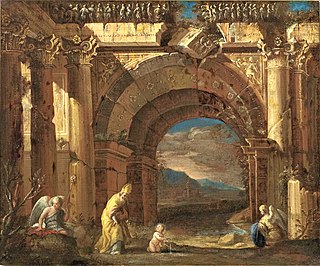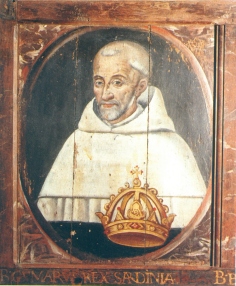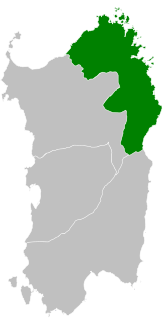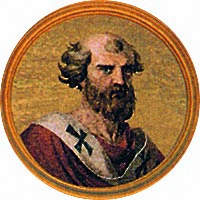Related Research Articles

Bernard of Clairvaux, venerated as Saint Bernard, was a Burgundian abbot and a major leader in the revitalization of Benedictine monasticism through the nascent Cistercian Order.
Pope Eugene III, born Bernardo Pignatelli, or possibly Paganelli, called Bernardo da Pisa, was head of the Catholic Church and ruler of the Papal States from 15 February 1145 to his death in 1153. He was the first Cistercian to become pope. In response to the fall of Edessa to the Muslims in 1144, Eugene proclaimed the Second Crusade. The crusade failed to recapture Edessa, which was the first of many failures by the Christians in the crusades to recapture lands won in the First Crusade. He was beatified in 1872 by Pope Pius IX.
Pope Lucius II, born Gherardo Caccianemici dal Orso, was head of the Catholic Church and ruler of the Papal States from 9 March 1144 to his death in 1145. His pontificate was notable for the unrest in Rome associated with the Commune of Rome and its attempts to wrest control of the city from the papacy. He supported Empress Matilda's claim to England in the Anarchy, and had a tense relationship with King Roger II of Sicily.
Anacletus II, born Pietro Pierleoni, was an antipope who ruled in opposition to Pope Innocent II from 1130 until his death in 1138. After the death of Pope Honorius II, the college of cardinals was divided over his successor. Unusually, the election was entrusted to eight cardinals, who elected Papareschi. A larger body of cardinals then elected Pierleoni, which led to a major schism in the Roman Catholic Church. Anacletus had the support of most Romans, including the Frangipani family, and Innocent was forced to flee to France. North of the Alps, Innocent gained the crucial support of the major religious orders, in particular Bernard of Clairvaux's Cistercians, the Abbot of Cluny Peter the Venerable; and Norbert of Xanten, the Archbishop of Magdeburg who established the Premonstratensians and held a high rank in the Court of the German Emperor Lothar III.

The Judicate of Arborea was one of the four independent judicates into which the island of Sardinia was divided in the Middle Ages. It occupied the central-west portion of the island, wedged between Logudoro to the north and east, Cagliari to the south and east, and the Mediterranean Sea to the west. To the north east and beyond Logudoro was located Gallura, with which Arborea had far less interaction. Arborea outlasted her neighbours, surviving well into the 15th century. The earliest known judicial seat was Tharros. The Kingdom of Arborea at the times of its maximum expansion occupied the whole island's territory, except the cities of Alghero and Cagliari.

Barison II or Barisone II was the giudice of Logudoro from 1153 to 1186. He was the son and successor of Gonario II, who retired to the monastery of Clairvaux to live out his days.
Comita III was the giudice of Logudoro, with its capital at Torres, from 1198 until 1218. He was the youngest of four sons of Barisone II of Torres and Preziosa de Orrubu. He ruled at a time when the great families, usually foreign, were superseding the giudici in power and influence on Sardinia.

Comita II was the giudice of the Giudicato of Arborea, from 1131 until his death. He was the son of Constantine I of Arborea, first ruler of Arborea of the Lacon dynasty. He married Elena de Orrubu, mother of Barison II of Arborea. The dating and chronology of his reign are obscure.

William I, regnal name Salusio IV, was the Giudice of Cagliari, or high Judge, from 1188 to his death. His descendants and those of his immediate competitors intermarried to form the backbone of the Italian Aristocracy, and ultimately their descendants in the Medici clan are precursors to, and definers of later royalty and claims thereto.

Gonario II was the giudice of Logudoro from the death of his father to his own abdication in 1154. He was a son of Constantine I and Marcusa de Gunale. He was born between 1113 and 1114 according to later sources and the Camaldolese church of S. Trinità di Saccargia was founded in his name by his parents on 16 December 1112, though it wasn't consecrated until 5 October 1116.
Uberto Lanfranchi was the Cardinal-deacon of Santa Maria in Via Lata, then the Cardinal-priest of San Clemente, and finally the Archbishop of Pisa.

Comita Spanu was the giudice of Gallura, in Sardinia, from 1133 to 1146. He was the son and successor of Constantine II.

The Judicate of Cagliari was one of the four Sardinian judicates of the Middle Ages, kingdoms of Byzantine origins.

The Judicate of Gallura was one of four Sardinian judicates in the Middle Ages. These were independent states whose rulers bore the title iudex, judge. Gallura, a name which comes from gallus, meaning rooster (cock), was subdivided into ten curatoriae governed by curatores under the judge. In the 13th century, the arms of Gallura contained a rooster.
Biagio was the Archbishop of Torres from 1 December 1202 to his death late 1214 or early 1215.

Benedetta was the daughter and heiress of William I of Cagliari and Adelasia, daughter of Moroello Malaspina. She succeeded her father in January or February 1214.

The Archdiocese of Pisa is a metropolitan see of the Catholic Church in Pisa, Italy. It was founded in the 4th century and elevated to the dignity of an archdiocese on 21 April 1092 by Pope Urban II. The seat of the bishop is the cathedral of the Assumption in the Piazza del Duomo.

Peter I, of the Serra family, was the eldest son and successor of Barisone II of Arborea, reigning from 1186 to his death. His mother was Barisone's first wife, Pellegrina de Lacon. He was crowned King of Sardinia, the title his father had used, with the support of a majority of the Arborean nobility.

The 1143 papal election followed the death of Pope Innocent II and resulted in the election of Pope Celestine II.
The Council of Pisa, was convened by Pope Innocent II in May 1135. An extraordinary number of prelates, archbishops, bishops, monks, and abbots attended the council, including a large number of Italian clergy. The council would address simony, schismatic clerics, and heresy, as well as establish donations to the Templar Order. Pisa would be the third council Innocent would convene to address issues within the Catholic Church.
References
- ↑ This is according to Klaus Ganzer, Die Entwicklung des auswärtigen Kardinalats in hohen Mittelalter, Tübingen 1963, p. 90. Other sources say that he was created cardinal in the Council of Clermont in November 1130 and that he was the first Cistercian Cardinal. Archived 23 September 2015 at the Wayback Machine
- ↑ According to Ganzer, 90, Baldwin's nomination as archbishop of Pisa took place in the middle of April 1138. Other sources give the year 1137. Archived 23 September 2015 at the Wayback Machine